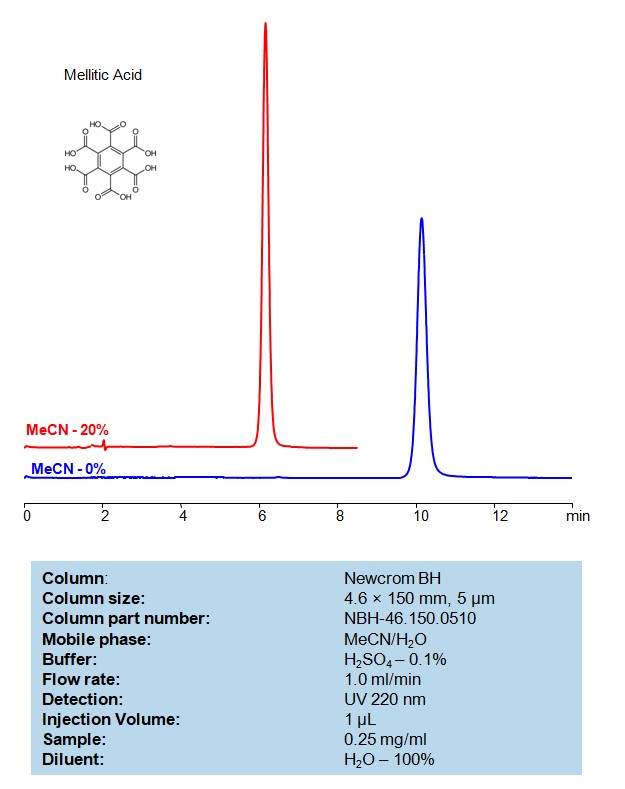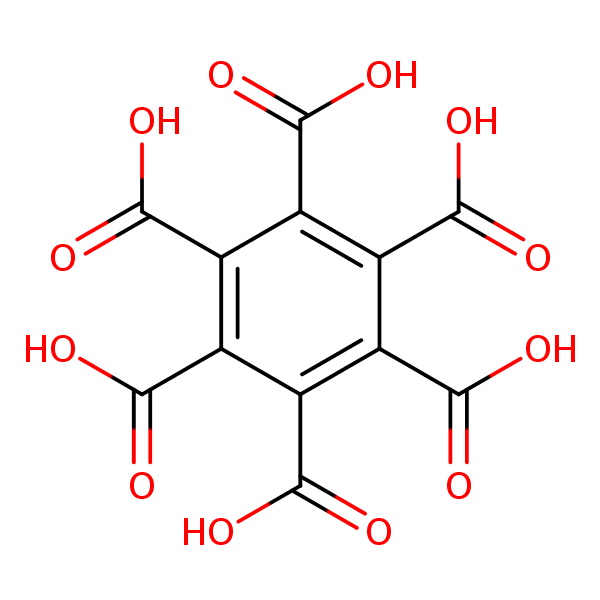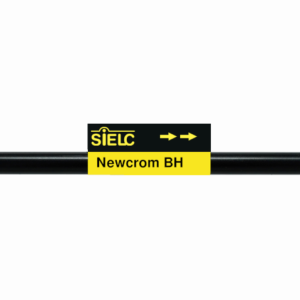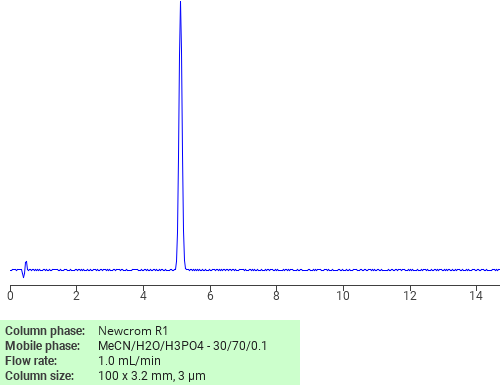| CAS Number | 517-60-2 |
|---|---|
| Molecular Formula | C12H6O12 |
| Molecular Weight | 342.168 |
| InChI Key | YDSWCNNOKPMOTP-UHFFFAOYSA-N |
| LogP | 1.50 |
| Synonyms |
|
Applications:
HPLC Method for Analysis of Mellitic Acid and Trimellitic Acid on Newcrom BH Column
March 6, 2024
HPLC Method for Analysis of Mellitic acid, Trimellitic Acid on Newcrom BH Column by SIELC Technologies
Separation type: Liquid Chromatography Reversed-phase

Mellitic Acid is an aromatic dicarboxylic acid with the chemical formula C12H6O12. It is a white crystalline solid and is derived from benzoic acid. Mellitic acid is named after mellite, a mineral in which it was first discovered. It is not commonly encountered in everyday use and does not have widespread applications.
Mellitic acid is mainly of interest in the fields of chemistry and mineralogy, and its practical applications are limited compared to other acids.
Trimellitic acid is a tricarboxylic acid with the chemical formula C9H6O6. It is also known as benzene-1,2,4-tricarboxylic acid. Trimellitic acid is used in various industrial applications, including the production of certain polymers and resins. It has three carboxylic acid functional groups, making it a useful building block in the synthesis of materials such as trimellitic anhydride (TMA), which is commonly employed in the manufacture of high-performance plastics. The unique structure and properties of trimellitic acid contribute to its role in specific chemical processes and the creation of specialized materials.
Mellitic acid and trimellitic acid can be retained, separated and analyzed on a reversed-phase Newcrom BH column with a mobile phase consisting of water, Acetonitrile (MeCN), and sulfuric acid. This analytical method can be detected with high resolution and peak symmetry at a wavelength of 220 nm using UV detection
High Performance Liquid Chromatography (HPLC) Method for Analyses of Mellitic acid, Trimellitic Acid on Newcrom BH Column by SIELC Technologies
Condition
| Column | Newcrom BH, 4.6 x 150 mm, 5 µm, 100 A, dual ended |
| Mobile Phase | MeCN/H2O |
| Buffer | H2SO4 – 0.1% |
| Flow Rate | 1.0 ml/min |
| Detection | UV 220 nm |
| Injection volume: | 2 µL |
| Sample | 0.1 mg/ml |
| Sample Diluent | H2O – 100% |
Description
| Class of Compounds | Acid |
| Analyzing Compounds | Mellitic acid, Trimellitic Acid |
Application Column
Newcrom BH
Column Diameter: 4.6 mm
Column Length: 150 mm
Particle Size: 5 µm
Pore Size: 100 A
Column options: dual ended
Trimellitic Acid

HPLC Method for Analysis of Mellitic Acid on Newcrom BH Column
March 1, 2024
HPLC Method for Analysis of Mellitic acid on Newcrom BH Column by SIELC Technologies
Separation type: Liquid Chromatography Reversed-phase

Mellitic Acid is an aromatic dicarboxylic acid with the chemical formula C12H6O12. It is a white crystalline solid and is derived from benzoic acid. Mellitic acid is named after mellite, a mineral in which it was first discovered. It is not commonly encountered in everyday use and does not have widespread applications.
Chemical Structure: Mellitic acid consists of a benzene ring with six carboxylic acid functional groups (-COOH) attached to it, forming a hexacarboxylic acid.
Occurrence: Mellitic acid is not a naturally abundant compound and is primarily known for its existence as a mineral, mellite, which contains mellitic acid.
Uses: Due to its structure and properties, mellitic acid does not have significant practical applications in industry or daily life. It is more commonly encountered in scientific contexts and research.
Derivatives: Mellitic acid can form various derivatives, and some of its salts and esters have been studied for specific purposes.
Mellitic acid is mainly of interest in the fields of chemistry and mineralogy, and its practical applications are limited compared to other acids.
Mellitic acid can be retained and analyzed on a reversed-phase Newcrom BH column with a mobile phase consisting of water, Acetonitrile (MeCN), and sulfuric acid. This analytical method can be detected with high resolution and peak symmetry at a wavelength of 220 nm using UV detection
High Performance Liquid Chromatography (HPLC) Method for Analyses of Mellitic acid on Newcrom BH Column by SIELC Technologies
Condition
| Column | Newcrom BH, 4.6 x 150 mm, 5 µm, 100 A, dual ended |
| Mobile Phase | MeCN/H2O |
| Buffer | H2SO4 – 0.1% |
| Flow Rate | 1.0 ml/min |
| Detection | UV 220 nm |
| Injection volume: | 1 µL |
| Sample | 0.25 mg/ml |
| Sample Diluent | H2O – 100% |
Description
| Class of Compounds | Acid |
| Analyzing Compounds | Mellitic acid |
Application Column
Newcrom BH
Column Diameter: 4.6 mm
Column Length: 150 mm
Particle Size: 5 µm
Pore Size: 100 A
Column options: dual ended

Separation of Mellitic acid on Newcrom R1 HPLC column
May 16, 2018
Mellitic acid can be analyzed by this reverse phase (RP) HPLC method with simple conditions. The mobile phase contains an acetonitrile (MeCN), water, and phosphoric acid. For Mass-Spec (MS) compatible applications the phosphoric acid needs to be replaced with formic acid. Smaller 3 µm particles columns available for fast UPLC applications. This liquid chromatography method is scalable and can be used for isolation impurities in preparative separation. It also suitable for pharmacokinetics.
Application Column
Newcrom R1
The Newcrom columns are a family of reverse-phase-based columns. Newcrom A, AH, B, and BH are all mixed-mode columns with either positive or negative ion-pairing groups attached to either short (25 Å) or long (100 Å) ligand chains. Newcrom R1 is a special reverse-phase column with low silanol activity.
Select options



